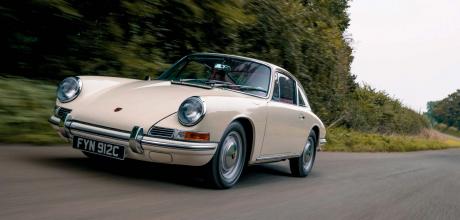1965 Porsche 912
Hot off the press. One of the very first right-hand drive 912s. Freshly restored following retirement from the road more than forty years ago, this 1965 Light Ivory 912 is not only one of the first three right-hand-drive examples produced, but also served as a press demonstrator for Porsche’s British sales outpost… Words Dan Furr. Photography Dan Sherwood.
RETRO REVIVALIST
912 PRESS CAR RELEASED BACK INTO THE WILD
Every German manufacturer had something new to offer at the forty-second Frankfurt Motor Show, which opened on Thursday 16th September, 1965. The Glas V8 broke cover, as did the Volkswagen Type 3 1600 TL, the updated Opel Rekord (pitched alongside the brand’s newly launched Kadett B and Karmann-built Diplomat convertible), the Auto Union Audi F103 1700, the Mercedes-Benz W108 and the NSU TT, a high-performance version of the Prinz 1000, launched at the same show two years prior. German brands also brought new and somewhat experimental body styles to the 1965 Frankfurt bash, with Opel’s GT sports coupe, NSU’s Wankel Spider hard-top and BMW’s Karmann-assembled New Class 2000 CS coupe providing a feast for the eyes, the latter carrying disproportionately tall front grilles not entirely out of harmony with the buck-toothed, ‘Bugs Bunny’ models rolling out of Munich today.
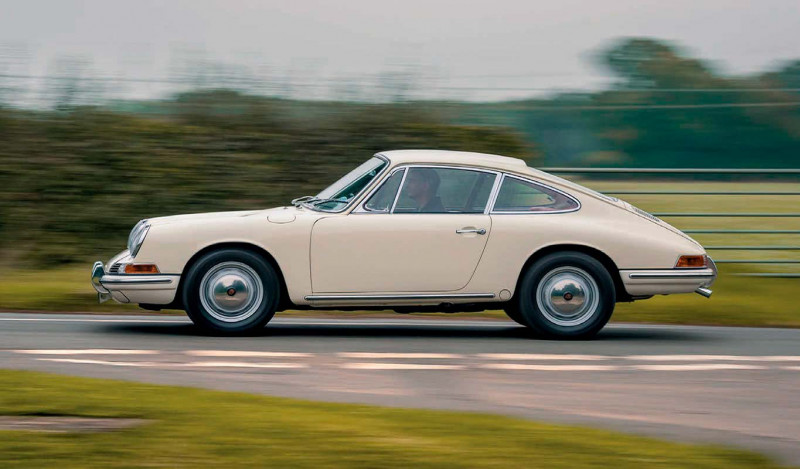
Porsche also unveiled a new design at the Frankfurt event. Presenting aTarga-topped 911, the brand caused a stir with what it described as “the new Porsche convertible”, resplendent with permanent rollover bar, a feature introduced to the 911 in response to factory bosses being concerned about rumoured (ultimately unrealised) plans for an update to North American road safety legislation. Ferry and his team were worried about pure drop-tops being banned in the USA following a high number of fatal accidents. By 1965, production figures showed Germany to be the second biggest producer of cars after the United States and, in 1964, some 750k units ahead of the United Kingdom. Though the majority of this success was down to the popularity of output from Volkswagen, which was enjoying a rate of trade equal to a car being sold every eight seconds, Porsche was keen to maintain lucrative export sales to the USA, which had become the brand’s biggest market and would remain as such for many decades, until China’s appetite for Stuttgart-crested SUVs saw the Cayenne and, later, the Macan, relegate Uncle Sam to second place. Moreover, open-top versions of thePorsche 356 had proved massively popular on the West Coast. The 911’s designer, Ferdinand ‘Butzi’ Porsche, resisted developing an al fresco version of the new six-cylinder model, stressing coupe styling and associated structural rigidity was essential to maintain the chassis dynamics and overall performance of the still-new Porsche flagship.
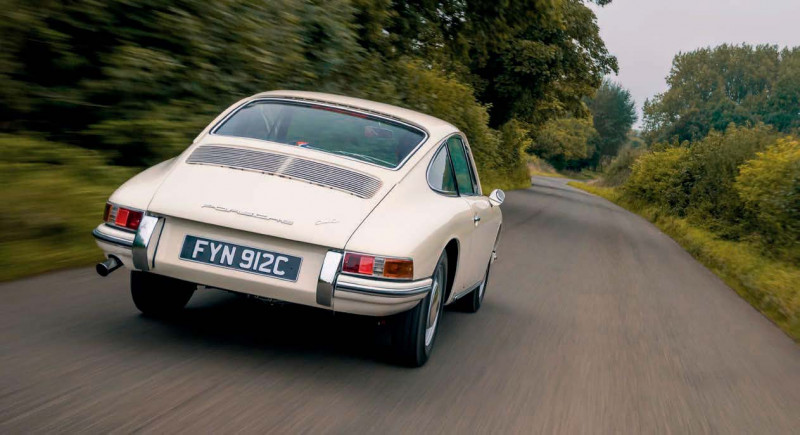
Nonetheless, the company needed something to fill the gap left by the outgoing 356 Cabriolet. An elegant rollover bar ahead of the 911’s back window and a lift-out roof panel (back then, a single, non-folding part) was the answer, bowing to laws the industry thought might come to pass in America, whilst ensuring the semi-open-top 911 kept as much of the coupe’s rigidity as possible. It would be another thirty-three years until the first full 911 Cabriolet was introduced.
VINTAGE PHOTOGRAPHS OF THE CAR CLEARLY SHOWING INTERIOR PARTS FROM THE MORE EXPENSIVE PORSCHE
Porsche faced another problem. Regardless of the body style you picked for your new 911, there was no getting away from the fact this was an expensive car, especially when compared to the purchase price of the outgoing 356. All new body styling, the associated tooling and the development of a new two-litre six-cylinder engine contributed to the cost, of course, but the jump in numbers saw customers vote with their wallets — sales of the 911 were much slower than anticipated, affording the 356 a short stay of execution. Porsche needed to act fast if it didn’t want to see its modest but valuable share of the sports car market in Europe and the USA rapidly decrease in size.
WORK THE PROBLEM
Following the high cost of developing the 911 and the continued growth of a money-hungry works motorsport programme, Porsche was in no position to develop a standalone model to fill the gap about to be left by the 356, which, by the time of the Frankfurt show, had been in production for almost two decades. The Targa — not an original design by any means, taking heavy influence from the body styles of the earlier Triumph TR4, SAAB Catherina prototype and the same-age Toyota UP15 Sports 800 — at least gave showroom visitors more choice (further hinted at by the Targa on display in Frankfurt wearing a pre-production set of the Fuchs five-leaf alloy wheels) and highlighted Porsche’s classleading standards of finish, but it was clear drastic measures were required to retain the level of sales the Stuttgart squad had been enjoying.
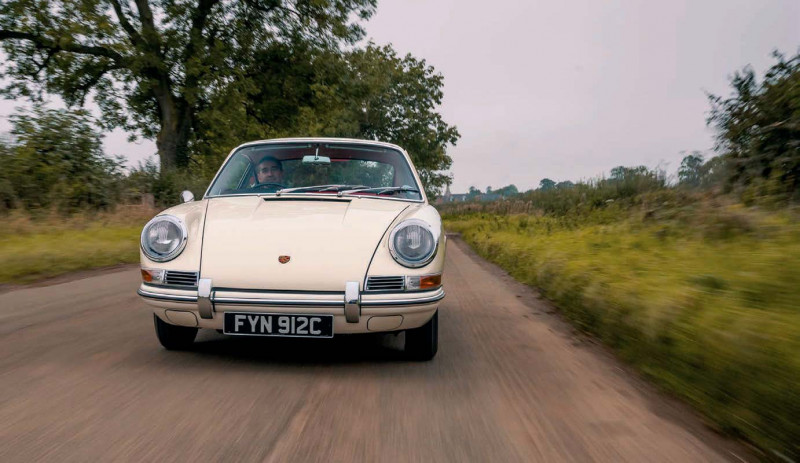
The solution to Porsche’s bother came in the form of the 912. By the time of the Frankfurt show, right-hand- drive 911s were landing in the UK and were being offered at a cost of £3,438 (including taxes) through AFN, the Stuttgart firm’s sole UK concessionaire. For the 1966 model year, however, and for almost £1,000 less, it was announced customers could buy a ‘lower’ specification version of the same car, powered by a development of the 356’s 1.6-litre flat-four. Essentially, Porsche was taking 911 body shells and chassis, fitting a four-cylinder boxer in place of the two-litre six-banger, removing various items of luxury trim (no wooden strips on the dashboard and a three-dial binnacle in place of the 911’s five gauges) and selling the resulting mash-up at two-thirds the cost of its flagship product. Even with the 912’s lesser performance taken into consideration — the sprint to 60mph from rest taking 11.9 seconds, the quarter-mile despatched in 18.2 seconds and 30mph to 70mph in third gear taking 13.9 seconds — the car’s claimed top speed of 115mph (in truth, 121mph is achievable from standard specification) coupled with identical looks to the 911 made the 912 impossible to ignore. Needless to say, it significantly outsold the 911 during the early phase of the smaller-engined model’s four-year spell in production, which ended with the arrival of the 914, Porsche’s next big-selling entry-level product, developed in partnership with Volkswagen and launched complete with Targa-top as standard equipment in 1969.
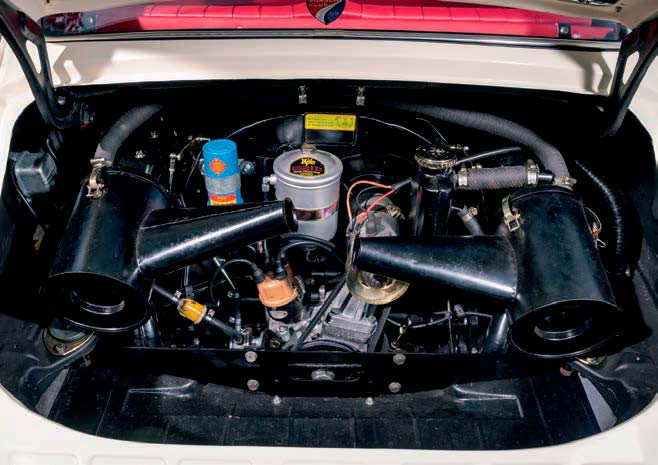
Joining the 911 Targa on Porsche’s exhibition stand in Frankfurt back in 1965 were two 911 coupes (one silver, one blue) and a bright yellow 912. With right-hand-drive versions of the 911 finally being built in Zuffenhausen for UK distribution, there was no delay in shipping same-configuration versions of the 912 to AFN and, in advance of the Earls Court Motor Show in October that year, the Isleworth-based dealer had already taken delivery of the first three examples bound for Blighty. FYN 912C (yes, that’s its original registration number) was one of them, retained by AFN and used as a company demonstrator. It even made appearances in the period’s motoring magazines, weighed up against other new-for-1966 models from established brands, though it’s difficult to imagine anyone looking at images of the Humber Sceptre II or Hillman Super Imp and being impressed with Rootes rides when pictures of the 912 were published alongside, even if the German coupe was double the price. Even so, it was thirty quid cheaper than the equally exotic — but considerably slower — Lancia Fulvia Coupe, released into the wild at the same time as the 912. Fuel economy wasn’t bad, either, with Porsche promising more than three hundred miles from a single tank of petrol. We dare say this figure would have been based on a car free of passengers, luggage and with a pilot avoiding ‘spirited’ driving.
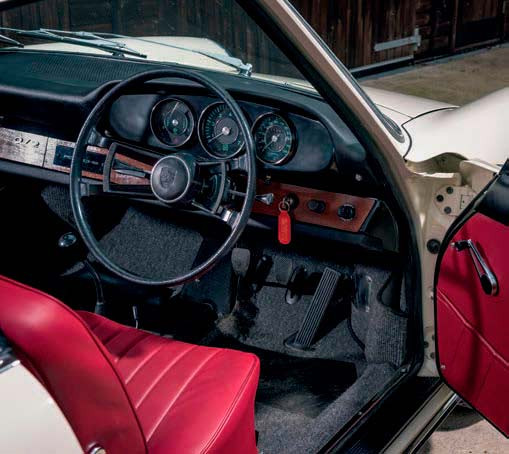
As is often the case when an automotive brand’s press mule has completed its promotional duties, has been driven hard at the hands of journalists who treat every car like an all-terrain vehicle and, in some instances, has been put through its paces by intrigued showroom visitors, FYN 912C was eventually sold by AFN to a private purchaser. The Light Ivory machine remained in regular use until 1979, when it was taken off the road to be partially stripped and recommissioned in readiness for another fifteen years of service. The then owner’s best laid plans, however, failed to bear fruit, resulting in the car being sold as a rolling shell accompanied by twenty boxes of removed parts. The same happened multiple times as the years went by, with pieces of trim and bodywork regrettably lost during each successive relocation. It wasn’t until a decade ago, when building contractor, Mark Leeding, was asked to provide an estimate for construction work at the home of an acquaintance, the car’s resurrection finally got underway.
“I was invited to the guy’s house and, as a sports car enthusiast, I couldn’t resist asking questions about the pair of classic Lotus Elans I spotted at the property,” recalls the self-confessed Porschephile, who was already in possession of a 911 Turbo (930), bought in 1999. “He explained they were his son’s cars, before inviting me to take a look at his Porsche project in waiting. He told me it was an early 912 used as a press car by AFN, but had been off the road since the late 1970s.” Recognising he had neither the time or resources to carry out the restoration, the owner revealed he was thinking about selling up, but needed to find a buyer who was brave enough to take on the build at a time 912s weren’t worth what they are today. “I was excited by what I saw,” Mark continues, “but I was also acutely aware of the fact what was on offer was little more than provenance. After all, without the origins of this car as an AFN demonstrator, all I’d be buying into was a derelict Porsche likely to cost far more to restore than it would ever be worth!”
LOOK SHARP
Wind the clock forward and Mark didn’t win the building contract, but he did come away with the 912. “I love early Porsches. They’re basic by modern standards, but they can provide just as much enjoyment when serving as a static object to stare at in your garage as they do when you’re bombing along behind the wheel. In particular, the 912 is a hugely involving Porsche, not only in the way it drives, but also in the way it looks. This is unquestionably a very pretty car.”
Although peak power of the 912 was no greater than its predecessor, the shape of the flat-four’s torque curve was improved for the newer Porsche, with 87lb-ft all the way from 2,800rpm to 5,000rpm, peaking at 90lb-ft at 3,600rpm. The 912’s 911-sourced underpinnings added weight, though, meaning the 912 is approximately ninety kilograms heavier than the car it replaced. In real-world terms, this means acceleration times aren’t improved until 60mph is reached and the 912’s better-streamlined body begins to have an effect. In other words, the dash to 60mph from rest is almost half a second slower than the 356, but from then on, the 912 proves superior, lopping a full two seconds off the time it takes the 356 to carry on to 100mph.
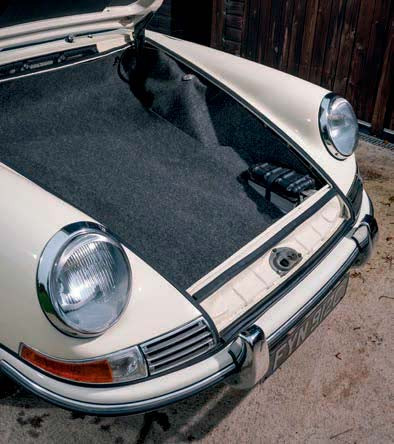
“I’m no restorer, but I reasoned I could just about get the car back up and running under my own steam,” Mark tells us. Missing many parts, he hopped online and searched for spares, a less than easy task when dealing with seriously old Porsches. “I needed headlamps and spotted an advertisement for the same right-hand- drive units this 912 was equipped with in 1965.”
The subsequent enquiry led him to the door of Mike Champion Engineering, the Banbury-based independent Porsche specialist showcased in last month’s issue of Classic Porsche. “On arrival at Mike’s workshop, I spotted two short-wheelbase 911s in different stages of restoration, as well as an early flat-four being rebuilt. It was clear to me this was someone more than capable of sympathetically restoring my car to its original condition. I also reasoned he probably had many of the missing parts I was looking for tucked away in his storeroom!”
Excited by Mark’s description of the car, Mike wasted no time in visiting Chez Leeding to view the Porsche for himself. “The engine case and transmission were in pieces,” he recalls. “The body shell had also been incorrectly repaired and one of the previous owners had carried out modifications, including butchering of the original light buckets to accommodate later lamp units. Thankfully, the Certificate of Authenticity proved the mechanical parts with the car to be original, even if they were in a terrible state. The paperwork also confirmed this 912’s build number as third in the sequence for right-hand- drive examples. This Porsche was quite a find.”
A simple case of getting the car to MCE, followed by strip down and fit-up, then? Sounds easy. It wasn’t, as Mark explains. “Perhaps because this car was destined to be driven by influential journalists and prospective Porsche purchasers, trim was closer to 911 than 912, making the car’s original specification different to factory stock,” he suggests. “We were keen to restore the car to how it was originally configured, rather than what general 912 specification dictated.” Mike supports the theory, pointing to vintage photographs of the car clearly showing interior parts from the more expensive Porsche when new, as opposed to them being retrofitted by a later owner. “The carpets, for example, were much thicker than you’d expect to find inside a 912.
There are also many other interior elements borrowed from the 911, including the wooden dashboard inserts.” They’d delaminated, but now look as good as new, in keeping with a cabin freshly retrimmed and making use of replacement red vinyl (or ‘leatherette’ as it is often referred to in Porsche paperwork) and new carpets.
MAKE A DIFFERENCE
As far as parts availability was concerned, Mark was correct in assuming much of what he needed was waiting to be discovered in MCE’s stockpile, although Mike still had to fabricate many parts from scratch, including the mounts for clocks, the wooden trim fasteners and the magnetic latch for the glovebox. The same was true of the engine crossmember, which Mike fabricated to the exact specification of the original. “Many people will think this isn’t keeping with what you should find beneath the deck lid of a 912, but the magazine articles and images published when this car was new show this is the design of the factory-fitted part. With a car as historically significant as this one, it’s important to do your research and observe original specification, rather than simply go for whatever the Porsche parts catalogue tells you was fitted to the model in general. Originality is king, as demonstrated by our treatment of the wings. It would have been easier to fit new panels after discovering the modifications, but Mark and I agreed it was important to retain as much of the original metalwork as possible, which is why we followed a route of repair or restore, rather than replace.”
The small demisting vents at the lower corners of the rear window pre-date Porsche’s adoption of heated electric screens. Mike remanufactured these items at the same time as rebuilding the seat mechanisms. The seats themselves had been retrimmed by a third-party at Mark’s instruction a few years ago, but other parts treated at the same time weren’t up to scratch. The interior rear quarter cards, for example, didn’t fit flush over the wheel arch bulges, necessitating further trimming work at MCE.
Our photographs were taken just as Mike was applying the finishing touches to the car after a through two-year restoration. Time for a road test. The first thing you notice in a Porsche of this vintage is the cabin noise.
Today, hearing a supremely healthy flat-four roaring from behind is all part of the 912’s charm, but when these cars were new, hearing a boisterous boxer relentlessly hammering away at the back (even with all windows closed) was a gripe of many reviewers. In response, Porsche introduced modified engine mounts to quieten the driving experience in later 912s, but during our time with the star car on these pages, we couldn’t get enough of the racket from the rear. Sliding through gear changes is a piece of cake, with silent shifting encouraged by the easy clutch and sublime transmission Mike has expertly rebuilt. This thing feels quick, too. Really quick. Where you might only be able to drive a similarly aged 911 at eight-tenths on the country roads we find ourselves bombing along, you can rinse a 912 for all it’s worth, driving flat-out and throwing the car into corners in a manner those without experience of 912s may doubt. It clings to bends even at license-baiting speed, the tail easy to keep in check. With every confidence in the ability of this air-cooled classic to follow our instructions to the letter, the only thing we were concerned with was whether the brakes were as impressive as the pace of acceleration. We needn’t have worried — the 912’s disc anchors (refurbished by Mike) provide plenty of bite at low speed and bring the car to a swift halt when travelling fast, something we put to the test time and again. All in the name of research, you understand.
The 912 was successful car in rallying, often beating 911s at their own game. Back when this car was new, seat belts were a cost-option intended to satisfy those who had motorsport ambitions. While we wholly appreciate Mark and Mike’s commitment to originality, it’s a retro-fit we’d have applied for peace of mind in modern traffic, no matter how capable the handling abilities of this car happen to be (kudos to Vredestein for the fantastic grip the brand’s Sprint Classic black circles deliver), but save for this personal preference, everything here is spot-on. It’s exactly the car AFN used to wow the media back in 1965. All credit to Mike for the exceptional restoration — in Mark’s hands, this classic Porsche is set to enjoy a new lease of life following decades lying dormant. Expect to see man and machine out and about during the coming show season, but prepare for the inevitable: after seeing this special 912 in the metal, you’ll be scanning classifieds for one to call your own. Fortunately, we know just the man to take care of any required remedial work!
Above Mark is looking forward to taking the car to shows and covering plenty of ground in the coming year. Above Interior features many parts borrowed from the 911, all fitted before motoring journalists reviewed the then new car in 1965.
Below Red vinyl against Light Ivory paintwork is a classic combination working as well today as it did when the car was built fifty-seven years ago.
Above The 912 is every bit as charming as a two-litre 911, but available to buy at much lower cost.
Below Porsche quoted a top speed of 115mph, though reviewers and brave owners have reported being able to exceed the digits on the dash.
Above Despite being supplied to Mike as little more than a shell and many boxes of removed parts, the original engine and transmission remained with the car.
Below The performance of the car is fantastic, offering the driver every opportunity to reach into zones they might think twice about exploring in a classic 911 on the same stretches of B-road.
Above Serial number places FYN 912C as one of the first three right-hand-drive 912s.
Below MCE has restored every inch of this beautiful four-cylinder Porsche across an exhaustive two-year build.


